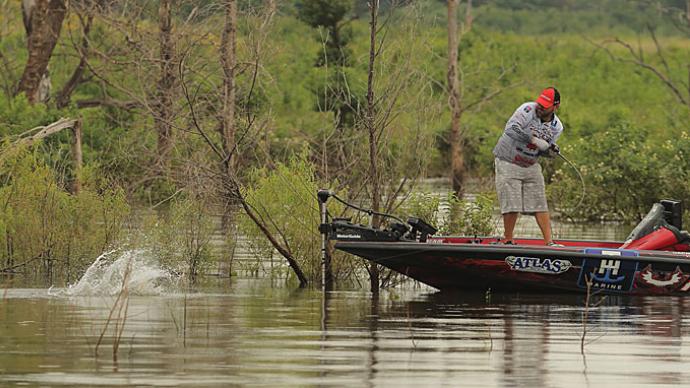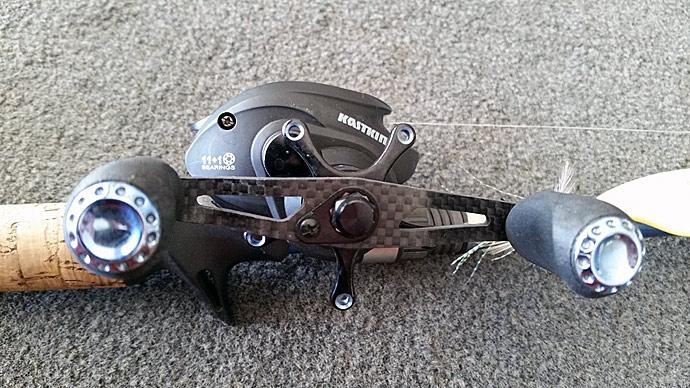These techniques are used on inactive bass, so a stealth approach and presentation are essential. They're best suited when fish have a small strike zone and are in off-color or muddy water. Flipping is best suited for murky water and dense cover, whereas pitching is the better choice in clear water and cover less thick. Floating vegetation and heavy cover are ideal targets to flip and pitch.
Don't limit yourself to the usual "jig-n-pig" setup. You can also flip and pitch worms and small finesse baits. Rig a tube jig or grub on a 1/4 ounce jig equipped with a weedguard. Sometimes these smaller profile baits are the ticket to putting a limit in the boat.
The Pitch Cast (Pitchin')
This is best for targets between 10 and 30 feet away and provides a very quiet lure entry. Use a rod 7 feet or longer and a single-hook lure such as a worm, jig, or spinnerbait. Face the target. Let out the line until the lure is even with the reel. Hold the lure in your free hand at waist level. Lower the rod tip toward the water and put tension on the line. In one smooth, quick motion, swing the rod tip toward the target and upward, letting go of the lure with your free hand. Use only your wrist; arm movement is not a factor. As the lure moves from beneath the rod tip, release the line and continue raising the rod tip. (On bait casting gear, this cast requires a very light setting on the spool tension control, and you must know how to control the spool with your thumb, or the reel will backlash.) The lure should fly just above the water. Use a combination of line tension and rod movement to guide it to the target and to make it touch down softly. If you stop the bait just before it enters the water, you'll almost always get a smooth entry. Immediately place your free hand on the reel and be ready for a strike.
The Flip-Cast (Flippin')
This is intended for pinpoint lure presentation to visible, thick cover between 10 and 20 feet away. Use a heavy-action 7 to 7 1/2-foot rod. Let out about 15 feet of line. With your free hand, grasp the line between the reel and the first rod guide and straighten your arm to the side. There should now be about 8 feet of line past the front tip. Raise the rod to make the lure swing back close to the body. Lower the rod top to make the lure swing forward. Use only your wrist, and roll the butt of the rod to the inside of your arm. As it moves past the rod tip, continue raising the rod as you feed the line with your free hand. As the lure nears the target, lower the rod top again and make the bait touch down softly and precisely on the target by stopping the bait just before it enters the water. Let go of the line in your free hand and immediately place it on the reel. Make sure you're ready to strike before beginning your retrieve.
Tips
- Use your wrist, NOT your arm.
- Concentrate on the spot you want to hit, not what you want to miss.
- Use plenty of scent when trying to penetrate thick cover - it acts as a lubricant.
- Stick to basic jig colors (black/blue, brown/brown, black/chartreuse).
- Use a plastic worm with a glass bead between the worm and the weight for inactive fish.
- If you think it's a strike, reel down until your rod is in a hookset position before you check.
- A strike is anything different (something you wouldn't feel in a bathtub!).
- Tighten your drag all the way down for better hooksets.
- Use 17 to 25-pound test line for bait casting gear 10 to 14-pound test on spinning (for flipping finesse baits).




